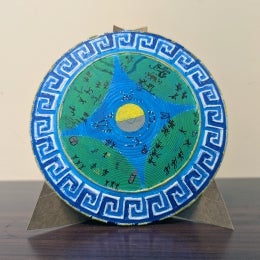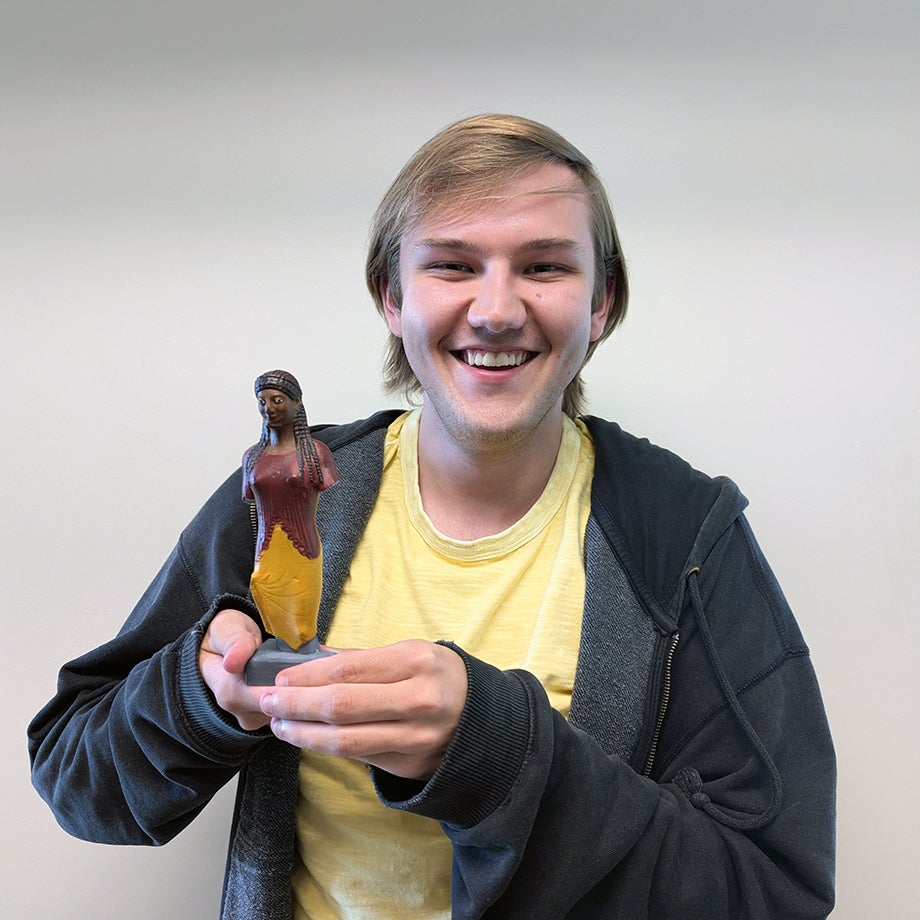
The Makerspace is a free, creative resource within the UCSB Library available to all students, faculty, and staff. We offer access to technology including 3D printing, laser cutting, sewing, electronics prototyping, and more.
Professor Annie Lamar, who directs the Low-Resource Language (LOREL) Lab in the Classics Department, recently integrated the Makerspace’s digital tools into her teaching. A specialist in low-resource computational linguistics with a focus on ancient Mediterranean languages and studies, Lamar asked her students to use 3D printing to connect with the material culture behind the texts they study, bringing cutting-edge technology to ancient studies.
Tell us about your class and the Makerspace project.
My advanced Greek language course for undergraduate and graduate students focuses on archaic Greek epic. Students chose an archaeological object relevant to archaic Greece, found or adapted an .stl file, 3D printed a replica in the Makerspace, and painted it. Each project also included an artist’s statement explaining the object’s significance and reflecting on artistic and technical choices.
Why bring 3D printing into a Greek language course?
 I decided to bring 3D printing into the class because I wanted students to experience the material culture of ancient Greece in a more hands-on way. In an advanced Greek course, we spend a lot of time with texts, but the stories and myths in those texts are deeply connected to the material world.
I decided to bring 3D printing into the class because I wanted students to experience the material culture of ancient Greece in a more hands-on way. In an advanced Greek course, we spend a lot of time with texts, but the stories and myths in those texts are deeply connected to the material world.
I wanted students to develop a deeper, more embodied understanding of these historical and cultural contexts. 3D printing offered a unique opportunity to bridge that gap. It allows students to physically interact with replicas of objects they might otherwise only see in textbooks or on screens. This hands-on approach transforms abstract concepts into concrete realities and fosters a different kind of engagement with the ancient world.
How did this change the way students engaged with the material?
 Traditionally, students' engagement with ancient artifacts might be limited to looking at images. By creating a physical replica, students develop a tactile and spatial understanding of these objects. This directly connects to discussions about the object's function and significance in ancient society. For instance, holding a 3D-printed replica of an amphora provides a much richer understanding of its use in daily life or ritual than simply seeing a picture. They can ask: Where are the handles? How would you hold this vase to pour oil or wine? What does the experience of handling this object tell us about its function, and how does that deepen our understanding of its role in textual scenes of feasting, drinking, and dining?
Traditionally, students' engagement with ancient artifacts might be limited to looking at images. By creating a physical replica, students develop a tactile and spatial understanding of these objects. This directly connects to discussions about the object's function and significance in ancient society. For instance, holding a 3D-printed replica of an amphora provides a much richer understanding of its use in daily life or ritual than simply seeing a picture. They can ask: Where are the handles? How would you hold this vase to pour oil or wine? What does the experience of handling this object tell us about its function, and how does that deepen our understanding of its role in textual scenes of feasting, drinking, and dining?
Beyond the physical interaction, the process of selecting an object and researching its significance for their artist's statement compels students to connect the artifact directly to the textual traditions we are studying. They have to think critically about why a particular vase, statue, or architectural element is relevant to archaic Greek literature or history, fostering a more holistic understanding of the time period. By engaging in the process of recreating these objects, students also gain a profound appreciation for the craftsmanship and effort involved in their original creation. It moves these artifacts from being distant museum pieces to relatable examples of human craftsmanship and artistry.
Furthermore, the technical aspects of 3D printing (e.g. finding appropriate .stl files, understanding printing limitations, and adapting designs) introduce an element of practical problem-solving. Students encounter real-world constraints and must think creatively to overcome them, much like ancient artisans would have faced material limitations. Their artist's statements often reflect on these ‘artistic choices’ that are born out of technical necessities, making this a valuable metacognitive exercise.
What role do creative technologies play in your teaching and research?
Creative technologies, like 3D printing, are transformative in humanities education, particularly in classical studies. They allow us to move beyond purely theoretical engagement and embrace a more active, discovery-based learning model. In my teaching, these technologies foster a multi-sensory approach to ancient material. It’s no longer just about reading Greek texts, but about seeing, touching, and even creating the world that these texts inhabited. This not only makes the content more engaging but also more memorable.
From a research perspective, while my primary research might not directly involve 3D printing, the pedagogical insights gained from this assignment certainly inform my understanding of how we can better bridge the gap between ancient texts and their material contexts. It encourages me to think about how digital tools and hands-on approaches can illuminate aspects of ancient life that might remain elusive through traditional scholarship alone. The ability to quickly prototype and visualize ancient structures or objects could also be incredibly valuable for future research endeavors in visualizing complex archaeological data or architectural reconstructions.
Interested in learning more about how you can adopt emerging technologies into your course curricula? View our Instructor Guide to the Makerspace for help with developing or facilitating creative assignments for your next course, or contact Maddie Wishart, Makerspace Manager.
Image Captions
- 3D printed replica of an ancient artifact
- A student holding 3D printed replica of an ancient Greek artifact
- 3D printed replica of an archaic Athena


